Business & Company Law BAF-5-BLA: Tort and Contract Law Case Study
VerifiedAdded on 2023/06/13
|14
|3395
|54
Case Study
AI Summary
This assignment presents a comprehensive analysis of business and company law, focusing on Tort Law and Contract Law principles. The first section delves into the sources of English Law, differentiating between legislation and common law, and contrasting public and private law. Landmark cases such as Donoghue v Stevenson, Caparo Industries plc v Dickman, and Hedley Byrne & Co Ltd v Heller & Partners Ltd are examined in relation to Tort Law. The second section analyzes a scenario involving an art gallery owner and potential buyers, addressing the concepts of invitation to treat, offer, acceptance, and the formation of a legally binding contract. The case study applies relevant legal rules and precedents to determine the rights and obligations of the parties involved, ultimately concluding whether a valid contract exists and if any legal action can be pursued.

Running Head: COMMERCIAL LAW 0
Business and Company Law
Business and Company Law
Secure Best Marks with AI Grader
Need help grading? Try our AI Grader for instant feedback on your assignments.
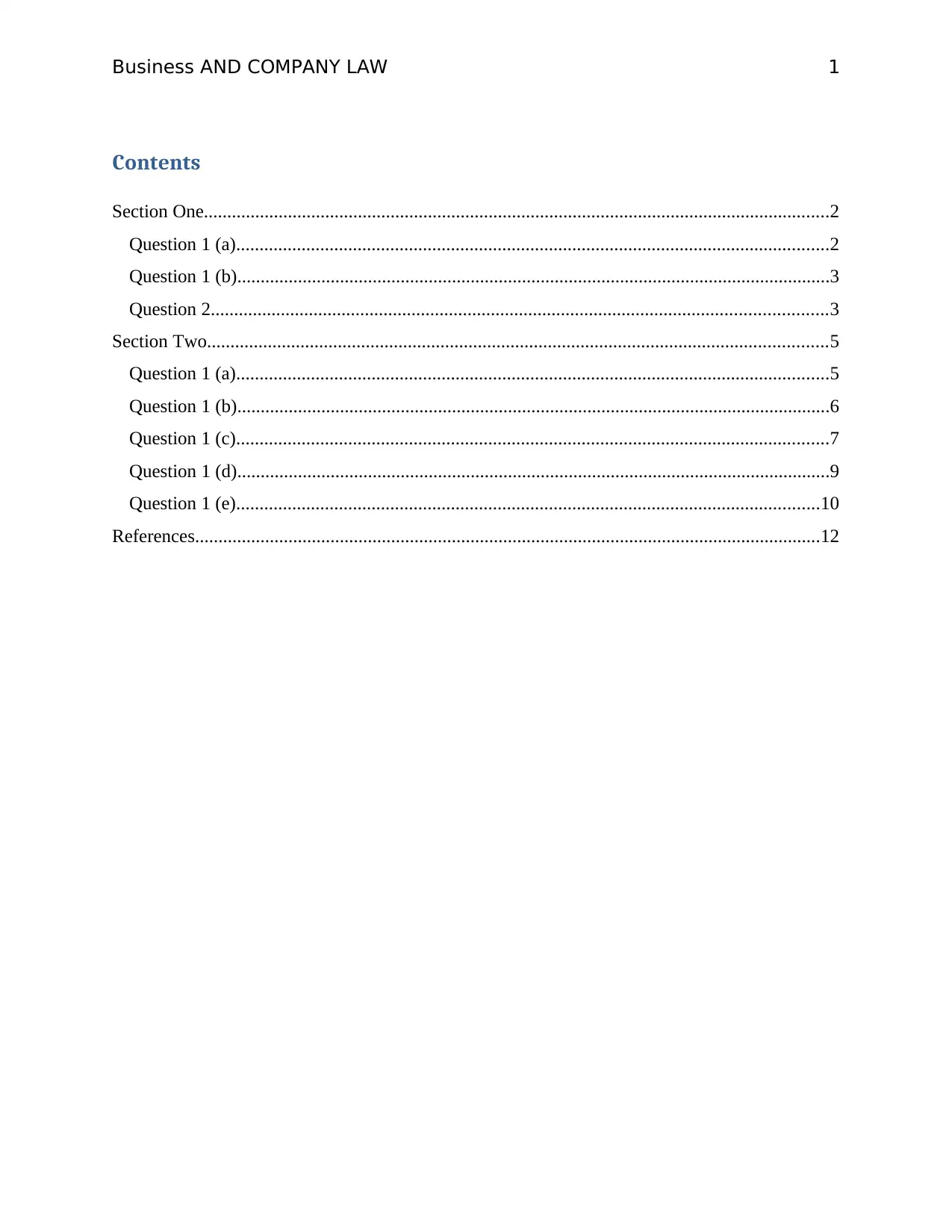
Business AND COMPANY LAW 1
Contents
Section One......................................................................................................................................2
Question 1 (a)...............................................................................................................................2
Question 1 (b)...............................................................................................................................3
Question 2....................................................................................................................................3
Section Two.....................................................................................................................................5
Question 1 (a)...............................................................................................................................5
Question 1 (b)...............................................................................................................................6
Question 1 (c)...............................................................................................................................7
Question 1 (d)...............................................................................................................................9
Question 1 (e).............................................................................................................................10
References......................................................................................................................................12
Contents
Section One......................................................................................................................................2
Question 1 (a)...............................................................................................................................2
Question 1 (b)...............................................................................................................................3
Question 2....................................................................................................................................3
Section Two.....................................................................................................................................5
Question 1 (a)...............................................................................................................................5
Question 1 (b)...............................................................................................................................6
Question 1 (c)...............................................................................................................................7
Question 1 (d)...............................................................................................................................9
Question 1 (e).............................................................................................................................10
References......................................................................................................................................12
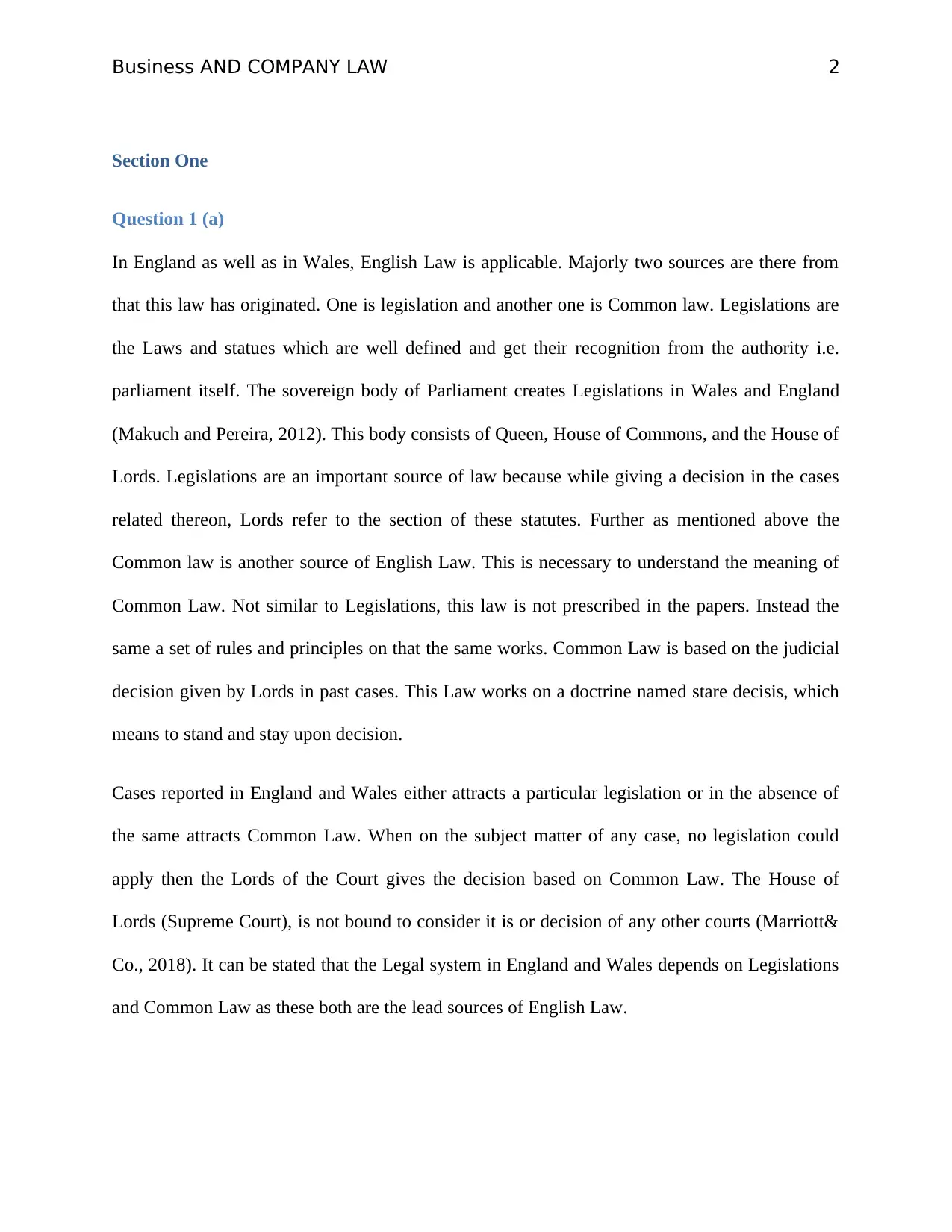
Business AND COMPANY LAW 2
Section One
Question 1 (a)
In England as well as in Wales, English Law is applicable. Majorly two sources are there from
that this law has originated. One is legislation and another one is Common law. Legislations are
the Laws and statues which are well defined and get their recognition from the authority i.e.
parliament itself. The sovereign body of Parliament creates Legislations in Wales and England
(Makuch and Pereira, 2012). This body consists of Queen, House of Commons, and the House of
Lords. Legislations are an important source of law because while giving a decision in the cases
related thereon, Lords refer to the section of these statutes. Further as mentioned above the
Common law is another source of English Law. This is necessary to understand the meaning of
Common Law. Not similar to Legislations, this law is not prescribed in the papers. Instead the
same a set of rules and principles on that the same works. Common Law is based on the judicial
decision given by Lords in past cases. This Law works on a doctrine named stare decisis, which
means to stand and stay upon decision.
Cases reported in England and Wales either attracts a particular legislation or in the absence of
the same attracts Common Law. When on the subject matter of any case, no legislation could
apply then the Lords of the Court gives the decision based on Common Law. The House of
Lords (Supreme Court), is not bound to consider it is or decision of any other courts (Marriott&
Co., 2018). It can be stated that the Legal system in England and Wales depends on Legislations
and Common Law as these both are the lead sources of English Law.
Section One
Question 1 (a)
In England as well as in Wales, English Law is applicable. Majorly two sources are there from
that this law has originated. One is legislation and another one is Common law. Legislations are
the Laws and statues which are well defined and get their recognition from the authority i.e.
parliament itself. The sovereign body of Parliament creates Legislations in Wales and England
(Makuch and Pereira, 2012). This body consists of Queen, House of Commons, and the House of
Lords. Legislations are an important source of law because while giving a decision in the cases
related thereon, Lords refer to the section of these statutes. Further as mentioned above the
Common law is another source of English Law. This is necessary to understand the meaning of
Common Law. Not similar to Legislations, this law is not prescribed in the papers. Instead the
same a set of rules and principles on that the same works. Common Law is based on the judicial
decision given by Lords in past cases. This Law works on a doctrine named stare decisis, which
means to stand and stay upon decision.
Cases reported in England and Wales either attracts a particular legislation or in the absence of
the same attracts Common Law. When on the subject matter of any case, no legislation could
apply then the Lords of the Court gives the decision based on Common Law. The House of
Lords (Supreme Court), is not bound to consider it is or decision of any other courts (Marriott&
Co., 2018). It can be stated that the Legal system in England and Wales depends on Legislations
and Common Law as these both are the lead sources of English Law.
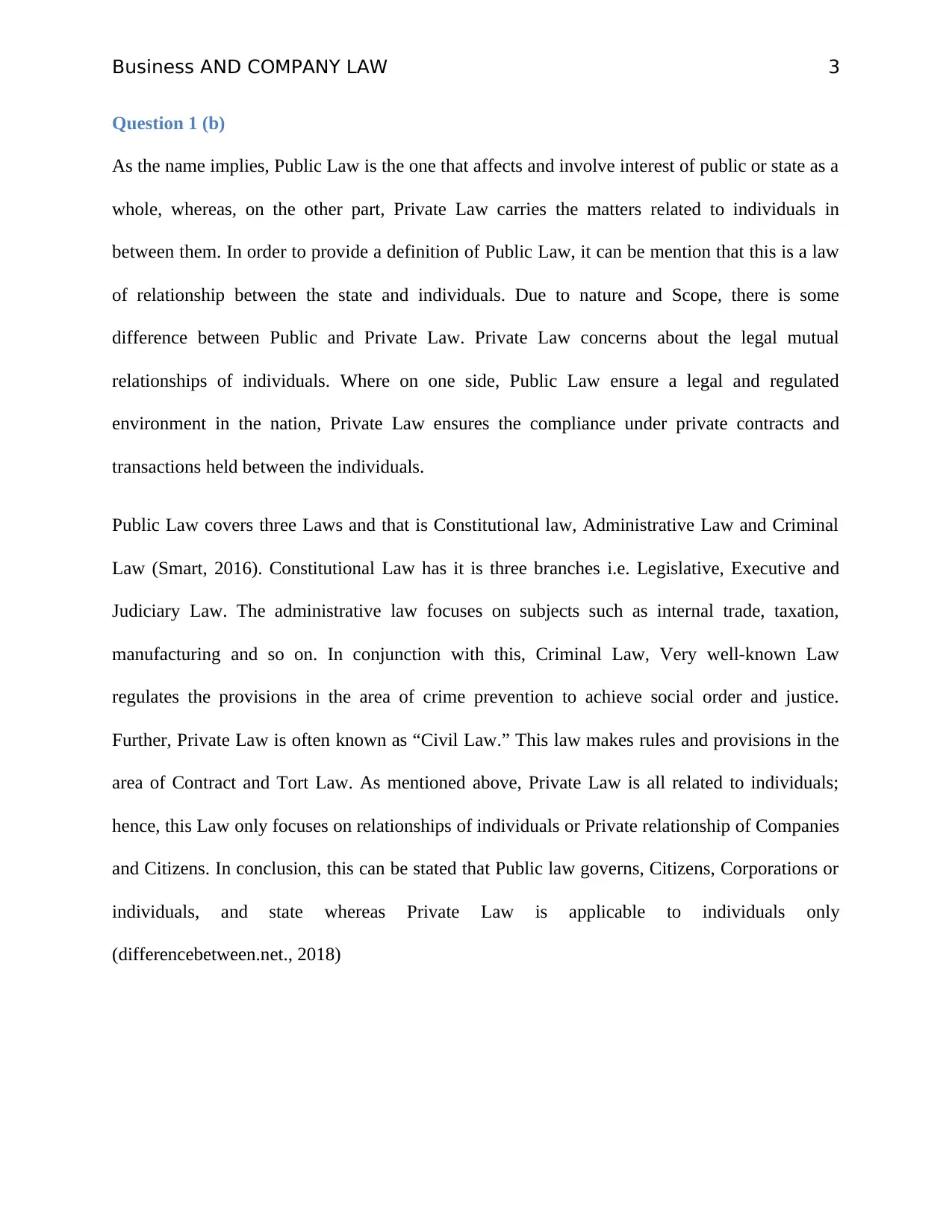
Business AND COMPANY LAW 3
Question 1 (b)
As the name implies, Public Law is the one that affects and involve interest of public or state as a
whole, whereas, on the other part, Private Law carries the matters related to individuals in
between them. In order to provide a definition of Public Law, it can be mention that this is a law
of relationship between the state and individuals. Due to nature and Scope, there is some
difference between Public and Private Law. Private Law concerns about the legal mutual
relationships of individuals. Where on one side, Public Law ensure a legal and regulated
environment in the nation, Private Law ensures the compliance under private contracts and
transactions held between the individuals.
Public Law covers three Laws and that is Constitutional law, Administrative Law and Criminal
Law (Smart, 2016). Constitutional Law has it is three branches i.e. Legislative, Executive and
Judiciary Law. The administrative law focuses on subjects such as internal trade, taxation,
manufacturing and so on. In conjunction with this, Criminal Law, Very well-known Law
regulates the provisions in the area of crime prevention to achieve social order and justice.
Further, Private Law is often known as “Civil Law.” This law makes rules and provisions in the
area of Contract and Tort Law. As mentioned above, Private Law is all related to individuals;
hence, this Law only focuses on relationships of individuals or Private relationship of Companies
and Citizens. In conclusion, this can be stated that Public law governs, Citizens, Corporations or
individuals, and state whereas Private Law is applicable to individuals only
(differencebetween.net., 2018)
Question 1 (b)
As the name implies, Public Law is the one that affects and involve interest of public or state as a
whole, whereas, on the other part, Private Law carries the matters related to individuals in
between them. In order to provide a definition of Public Law, it can be mention that this is a law
of relationship between the state and individuals. Due to nature and Scope, there is some
difference between Public and Private Law. Private Law concerns about the legal mutual
relationships of individuals. Where on one side, Public Law ensure a legal and regulated
environment in the nation, Private Law ensures the compliance under private contracts and
transactions held between the individuals.
Public Law covers three Laws and that is Constitutional law, Administrative Law and Criminal
Law (Smart, 2016). Constitutional Law has it is three branches i.e. Legislative, Executive and
Judiciary Law. The administrative law focuses on subjects such as internal trade, taxation,
manufacturing and so on. In conjunction with this, Criminal Law, Very well-known Law
regulates the provisions in the area of crime prevention to achieve social order and justice.
Further, Private Law is often known as “Civil Law.” This law makes rules and provisions in the
area of Contract and Tort Law. As mentioned above, Private Law is all related to individuals;
hence, this Law only focuses on relationships of individuals or Private relationship of Companies
and Citizens. In conclusion, this can be stated that Public law governs, Citizens, Corporations or
individuals, and state whereas Private Law is applicable to individuals only
(differencebetween.net., 2018)
Secure Best Marks with AI Grader
Need help grading? Try our AI Grader for instant feedback on your assignments.
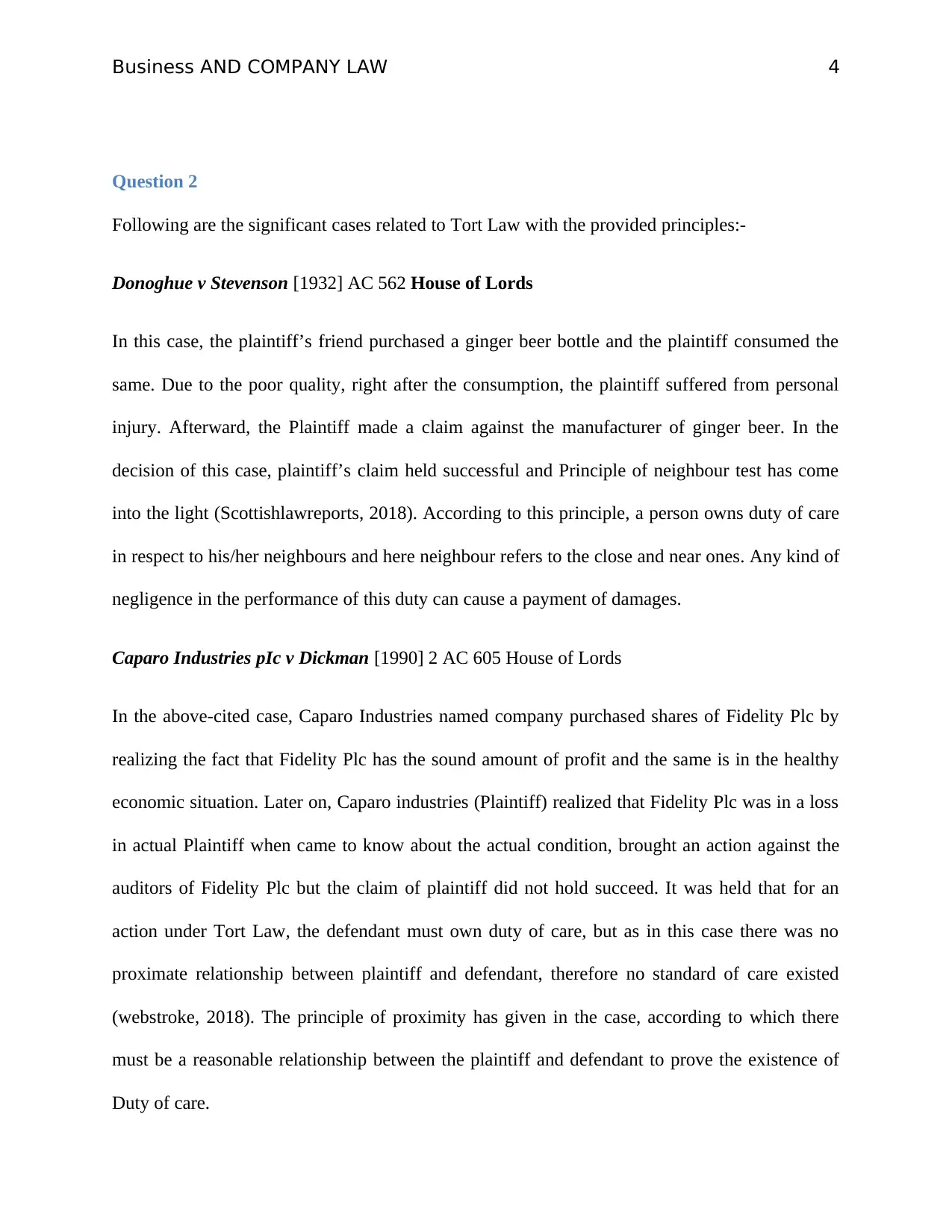
Business AND COMPANY LAW 4
Question 2
Following are the significant cases related to Tort Law with the provided principles:-
Donoghue v Stevenson [1932] AC 562 House of Lords
In this case, the plaintiff’s friend purchased a ginger beer bottle and the plaintiff consumed the
same. Due to the poor quality, right after the consumption, the plaintiff suffered from personal
injury. Afterward, the Plaintiff made a claim against the manufacturer of ginger beer. In the
decision of this case, plaintiff’s claim held successful and Principle of neighbour test has come
into the light (Scottishlawreports, 2018). According to this principle, a person owns duty of care
in respect to his/her neighbours and here neighbour refers to the close and near ones. Any kind of
negligence in the performance of this duty can cause a payment of damages.
Caparo Industries pIc v Dickman [1990] 2 AC 605 House of Lords
In the above-cited case, Caparo Industries named company purchased shares of Fidelity Plc by
realizing the fact that Fidelity Plc has the sound amount of profit and the same is in the healthy
economic situation. Later on, Caparo industries (Plaintiff) realized that Fidelity Plc was in a loss
in actual Plaintiff when came to know about the actual condition, brought an action against the
auditors of Fidelity Plc but the claim of plaintiff did not hold succeed. It was held that for an
action under Tort Law, the defendant must own duty of care, but as in this case there was no
proximate relationship between plaintiff and defendant, therefore no standard of care existed
(webstroke, 2018). The principle of proximity has given in the case, according to which there
must be a reasonable relationship between the plaintiff and defendant to prove the existence of
Duty of care.
Question 2
Following are the significant cases related to Tort Law with the provided principles:-
Donoghue v Stevenson [1932] AC 562 House of Lords
In this case, the plaintiff’s friend purchased a ginger beer bottle and the plaintiff consumed the
same. Due to the poor quality, right after the consumption, the plaintiff suffered from personal
injury. Afterward, the Plaintiff made a claim against the manufacturer of ginger beer. In the
decision of this case, plaintiff’s claim held successful and Principle of neighbour test has come
into the light (Scottishlawreports, 2018). According to this principle, a person owns duty of care
in respect to his/her neighbours and here neighbour refers to the close and near ones. Any kind of
negligence in the performance of this duty can cause a payment of damages.
Caparo Industries pIc v Dickman [1990] 2 AC 605 House of Lords
In the above-cited case, Caparo Industries named company purchased shares of Fidelity Plc by
realizing the fact that Fidelity Plc has the sound amount of profit and the same is in the healthy
economic situation. Later on, Caparo industries (Plaintiff) realized that Fidelity Plc was in a loss
in actual Plaintiff when came to know about the actual condition, brought an action against the
auditors of Fidelity Plc but the claim of plaintiff did not hold succeed. It was held that for an
action under Tort Law, the defendant must own duty of care, but as in this case there was no
proximate relationship between plaintiff and defendant, therefore no standard of care existed
(webstroke, 2018). The principle of proximity has given in the case, according to which there
must be a reasonable relationship between the plaintiff and defendant to prove the existence of
Duty of care.
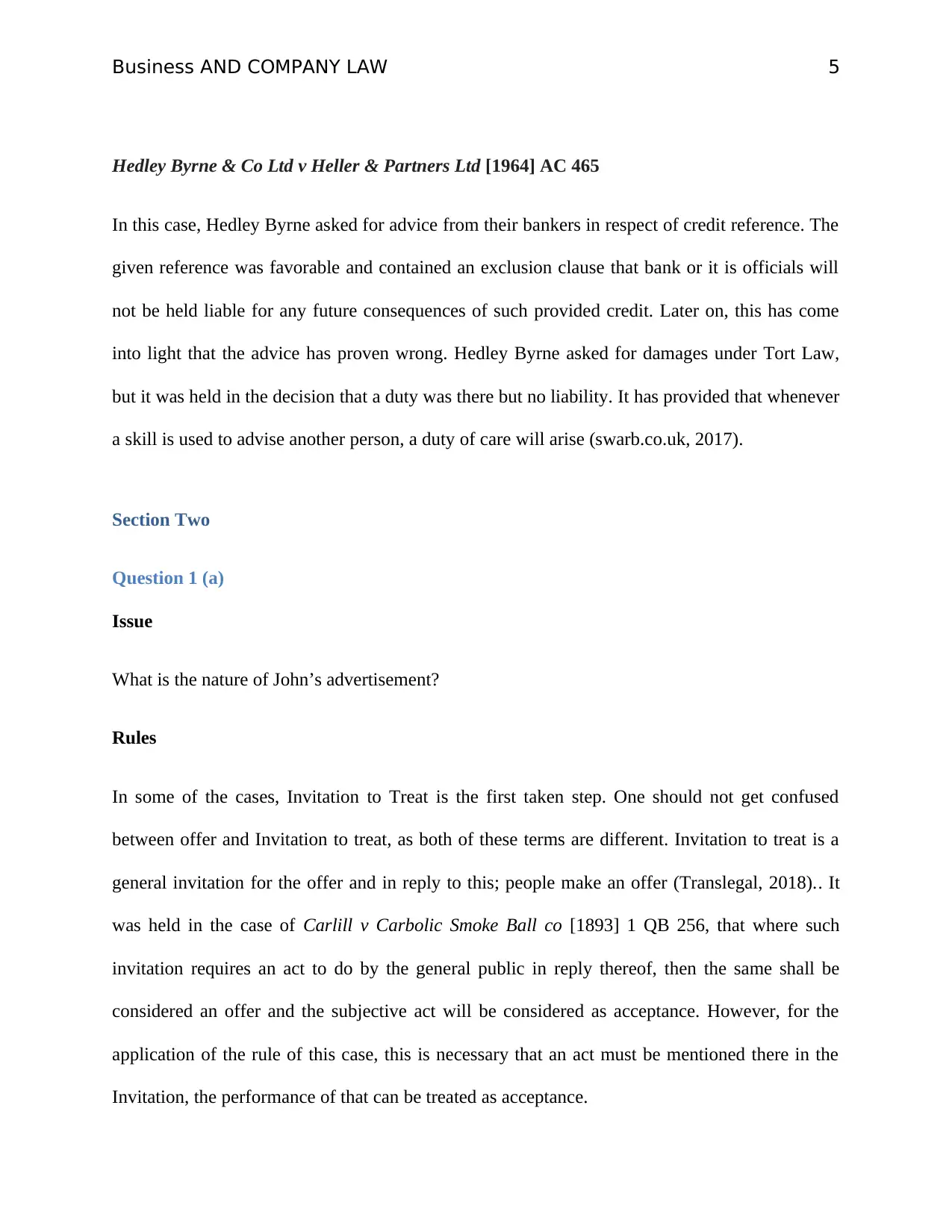
Business AND COMPANY LAW 5
Hedley Byrne & Co Ltd v Heller & Partners Ltd [1964] AC 465
In this case, Hedley Byrne asked for advice from their bankers in respect of credit reference. The
given reference was favorable and contained an exclusion clause that bank or it is officials will
not be held liable for any future consequences of such provided credit. Later on, this has come
into light that the advice has proven wrong. Hedley Byrne asked for damages under Tort Law,
but it was held in the decision that a duty was there but no liability. It has provided that whenever
a skill is used to advise another person, a duty of care will arise (swarb.co.uk, 2017).
Section Two
Question 1 (a)
Issue
What is the nature of John’s advertisement?
Rules
In some of the cases, Invitation to Treat is the first taken step. One should not get confused
between offer and Invitation to treat, as both of these terms are different. Invitation to treat is a
general invitation for the offer and in reply to this; people make an offer (Translegal, 2018).. It
was held in the case of Carlill v Carbolic Smoke Ball co [1893] 1 QB 256, that where such
invitation requires an act to do by the general public in reply thereof, then the same shall be
considered an offer and the subjective act will be considered as acceptance. However, for the
application of the rule of this case, this is necessary that an act must be mentioned there in the
Invitation, the performance of that can be treated as acceptance.
Hedley Byrne & Co Ltd v Heller & Partners Ltd [1964] AC 465
In this case, Hedley Byrne asked for advice from their bankers in respect of credit reference. The
given reference was favorable and contained an exclusion clause that bank or it is officials will
not be held liable for any future consequences of such provided credit. Later on, this has come
into light that the advice has proven wrong. Hedley Byrne asked for damages under Tort Law,
but it was held in the decision that a duty was there but no liability. It has provided that whenever
a skill is used to advise another person, a duty of care will arise (swarb.co.uk, 2017).
Section Two
Question 1 (a)
Issue
What is the nature of John’s advertisement?
Rules
In some of the cases, Invitation to Treat is the first taken step. One should not get confused
between offer and Invitation to treat, as both of these terms are different. Invitation to treat is a
general invitation for the offer and in reply to this; people make an offer (Translegal, 2018).. It
was held in the case of Carlill v Carbolic Smoke Ball co [1893] 1 QB 256, that where such
invitation requires an act to do by the general public in reply thereof, then the same shall be
considered an offer and the subjective act will be considered as acceptance. However, for the
application of the rule of this case, this is necessary that an act must be mentioned there in the
Invitation, the performance of that can be treated as acceptance.
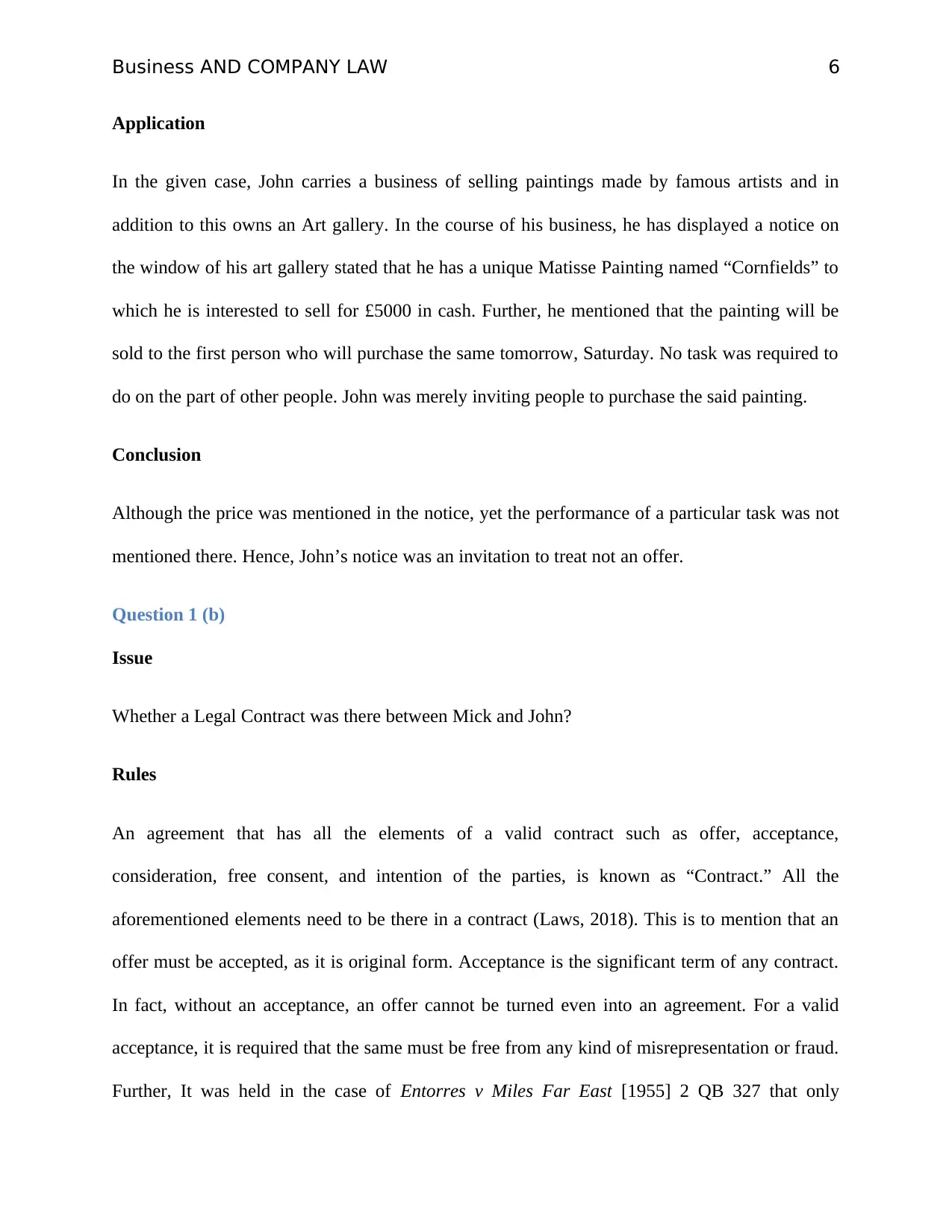
Business AND COMPANY LAW 6
Application
In the given case, John carries a business of selling paintings made by famous artists and in
addition to this owns an Art gallery. In the course of his business, he has displayed a notice on
the window of his art gallery stated that he has a unique Matisse Painting named “Cornfields” to
which he is interested to sell for £5000 in cash. Further, he mentioned that the painting will be
sold to the first person who will purchase the same tomorrow, Saturday. No task was required to
do on the part of other people. John was merely inviting people to purchase the said painting.
Conclusion
Although the price was mentioned in the notice, yet the performance of a particular task was not
mentioned there. Hence, John’s notice was an invitation to treat not an offer.
Question 1 (b)
Issue
Whether a Legal Contract was there between Mick and John?
Rules
An agreement that has all the elements of a valid contract such as offer, acceptance,
consideration, free consent, and intention of the parties, is known as “Contract.” All the
aforementioned elements need to be there in a contract (Laws, 2018). This is to mention that an
offer must be accepted, as it is original form. Acceptance is the significant term of any contract.
In fact, without an acceptance, an offer cannot be turned even into an agreement. For a valid
acceptance, it is required that the same must be free from any kind of misrepresentation or fraud.
Further, It was held in the case of Entorres v Miles Far East [1955] 2 QB 327 that only
Application
In the given case, John carries a business of selling paintings made by famous artists and in
addition to this owns an Art gallery. In the course of his business, he has displayed a notice on
the window of his art gallery stated that he has a unique Matisse Painting named “Cornfields” to
which he is interested to sell for £5000 in cash. Further, he mentioned that the painting will be
sold to the first person who will purchase the same tomorrow, Saturday. No task was required to
do on the part of other people. John was merely inviting people to purchase the said painting.
Conclusion
Although the price was mentioned in the notice, yet the performance of a particular task was not
mentioned there. Hence, John’s notice was an invitation to treat not an offer.
Question 1 (b)
Issue
Whether a Legal Contract was there between Mick and John?
Rules
An agreement that has all the elements of a valid contract such as offer, acceptance,
consideration, free consent, and intention of the parties, is known as “Contract.” All the
aforementioned elements need to be there in a contract (Laws, 2018). This is to mention that an
offer must be accepted, as it is original form. Acceptance is the significant term of any contract.
In fact, without an acceptance, an offer cannot be turned even into an agreement. For a valid
acceptance, it is required that the same must be free from any kind of misrepresentation or fraud.
Further, It was held in the case of Entorres v Miles Far East [1955] 2 QB 327 that only
Paraphrase This Document
Need a fresh take? Get an instant paraphrase of this document with our AI Paraphraser
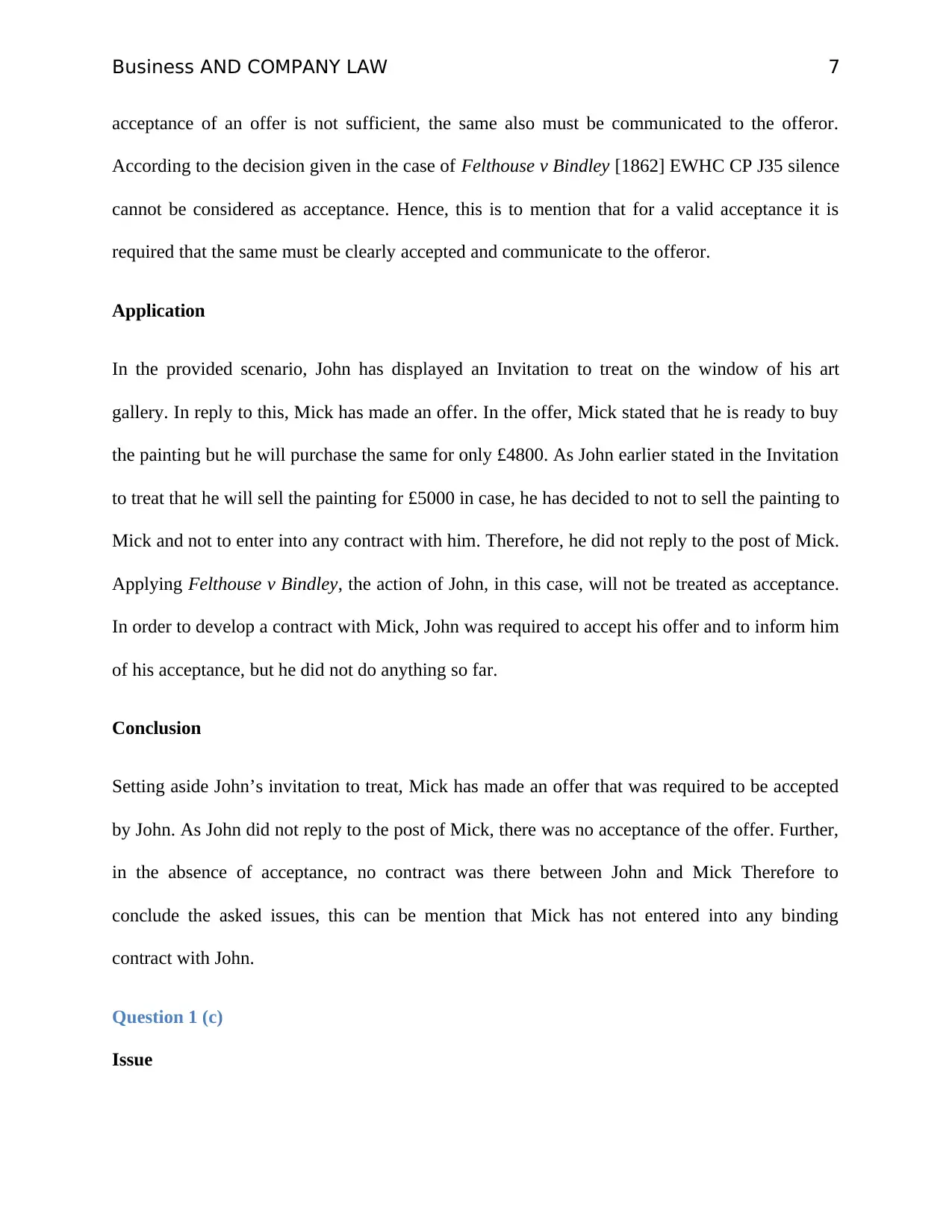
Business AND COMPANY LAW 7
acceptance of an offer is not sufficient, the same also must be communicated to the offeror.
According to the decision given in the case of Felthouse v Bindley [1862] EWHC CP J35 silence
cannot be considered as acceptance. Hence, this is to mention that for a valid acceptance it is
required that the same must be clearly accepted and communicate to the offeror.
Application
In the provided scenario, John has displayed an Invitation to treat on the window of his art
gallery. In reply to this, Mick has made an offer. In the offer, Mick stated that he is ready to buy
the painting but he will purchase the same for only £4800. As John earlier stated in the Invitation
to treat that he will sell the painting for £5000 in case, he has decided to not to sell the painting to
Mick and not to enter into any contract with him. Therefore, he did not reply to the post of Mick.
Applying Felthouse v Bindley, the action of John, in this case, will not be treated as acceptance.
In order to develop a contract with Mick, John was required to accept his offer and to inform him
of his acceptance, but he did not do anything so far.
Conclusion
Setting aside John’s invitation to treat, Mick has made an offer that was required to be accepted
by John. As John did not reply to the post of Mick, there was no acceptance of the offer. Further,
in the absence of acceptance, no contract was there between John and Mick Therefore to
conclude the asked issues, this can be mention that Mick has not entered into any binding
contract with John.
Question 1 (c)
Issue
acceptance of an offer is not sufficient, the same also must be communicated to the offeror.
According to the decision given in the case of Felthouse v Bindley [1862] EWHC CP J35 silence
cannot be considered as acceptance. Hence, this is to mention that for a valid acceptance it is
required that the same must be clearly accepted and communicate to the offeror.
Application
In the provided scenario, John has displayed an Invitation to treat on the window of his art
gallery. In reply to this, Mick has made an offer. In the offer, Mick stated that he is ready to buy
the painting but he will purchase the same for only £4800. As John earlier stated in the Invitation
to treat that he will sell the painting for £5000 in case, he has decided to not to sell the painting to
Mick and not to enter into any contract with him. Therefore, he did not reply to the post of Mick.
Applying Felthouse v Bindley, the action of John, in this case, will not be treated as acceptance.
In order to develop a contract with Mick, John was required to accept his offer and to inform him
of his acceptance, but he did not do anything so far.
Conclusion
Setting aside John’s invitation to treat, Mick has made an offer that was required to be accepted
by John. As John did not reply to the post of Mick, there was no acceptance of the offer. Further,
in the absence of acceptance, no contract was there between John and Mick Therefore to
conclude the asked issues, this can be mention that Mick has not entered into any binding
contract with John.
Question 1 (c)
Issue
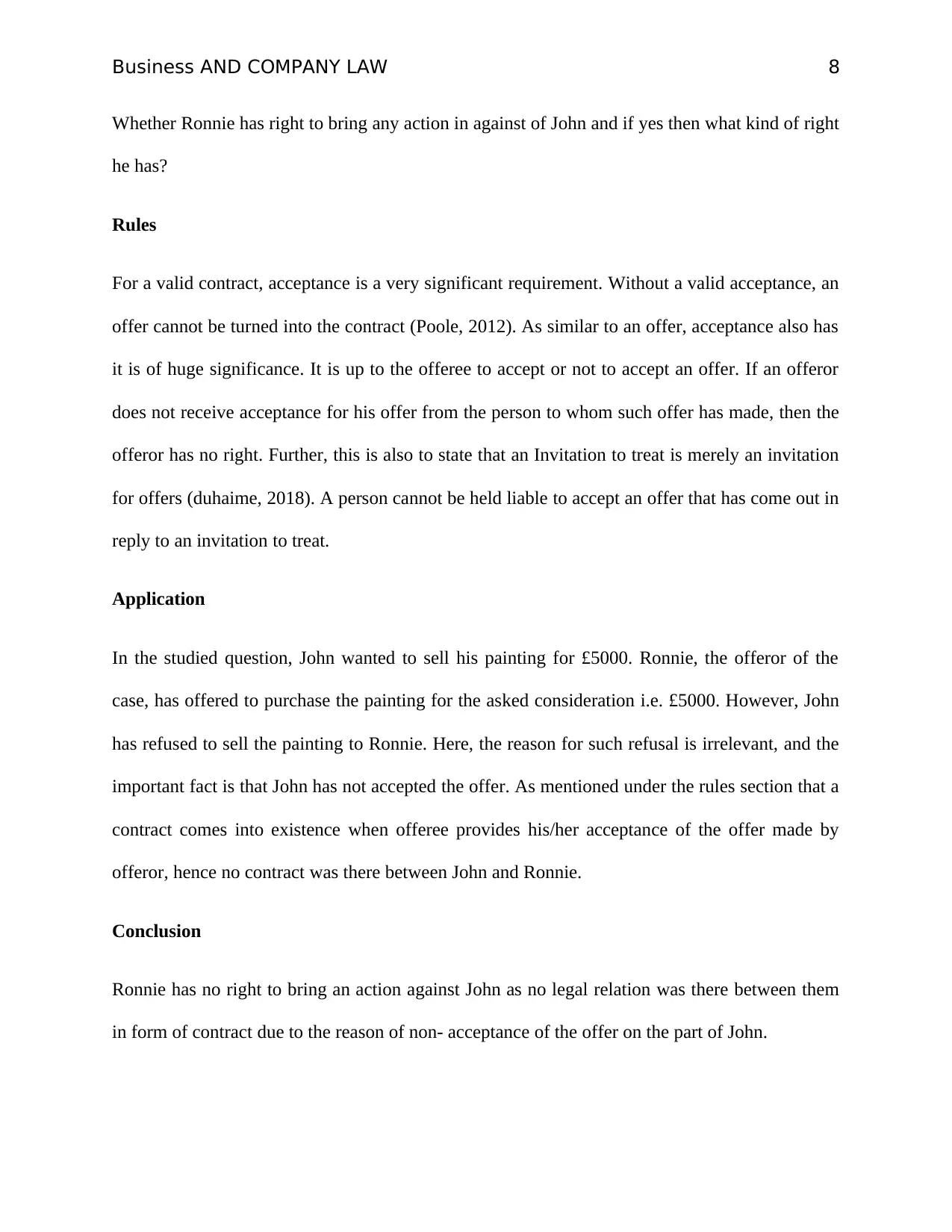
Business AND COMPANY LAW 8
Whether Ronnie has right to bring any action in against of John and if yes then what kind of right
he has?
Rules
For a valid contract, acceptance is a very significant requirement. Without a valid acceptance, an
offer cannot be turned into the contract (Poole, 2012). As similar to an offer, acceptance also has
it is of huge significance. It is up to the offeree to accept or not to accept an offer. If an offeror
does not receive acceptance for his offer from the person to whom such offer has made, then the
offeror has no right. Further, this is also to state that an Invitation to treat is merely an invitation
for offers (duhaime, 2018). A person cannot be held liable to accept an offer that has come out in
reply to an invitation to treat.
Application
In the studied question, John wanted to sell his painting for £5000. Ronnie, the offeror of the
case, has offered to purchase the painting for the asked consideration i.e. £5000. However, John
has refused to sell the painting to Ronnie. Here, the reason for such refusal is irrelevant, and the
important fact is that John has not accepted the offer. As mentioned under the rules section that a
contract comes into existence when offeree provides his/her acceptance of the offer made by
offeror, hence no contract was there between John and Ronnie.
Conclusion
Ronnie has no right to bring an action against John as no legal relation was there between them
in form of contract due to the reason of non- acceptance of the offer on the part of John.
Whether Ronnie has right to bring any action in against of John and if yes then what kind of right
he has?
Rules
For a valid contract, acceptance is a very significant requirement. Without a valid acceptance, an
offer cannot be turned into the contract (Poole, 2012). As similar to an offer, acceptance also has
it is of huge significance. It is up to the offeree to accept or not to accept an offer. If an offeror
does not receive acceptance for his offer from the person to whom such offer has made, then the
offeror has no right. Further, this is also to state that an Invitation to treat is merely an invitation
for offers (duhaime, 2018). A person cannot be held liable to accept an offer that has come out in
reply to an invitation to treat.
Application
In the studied question, John wanted to sell his painting for £5000. Ronnie, the offeror of the
case, has offered to purchase the painting for the asked consideration i.e. £5000. However, John
has refused to sell the painting to Ronnie. Here, the reason for such refusal is irrelevant, and the
important fact is that John has not accepted the offer. As mentioned under the rules section that a
contract comes into existence when offeree provides his/her acceptance of the offer made by
offeror, hence no contract was there between John and Ronnie.
Conclusion
Ronnie has no right to bring an action against John as no legal relation was there between them
in form of contract due to the reason of non- acceptance of the offer on the part of John.
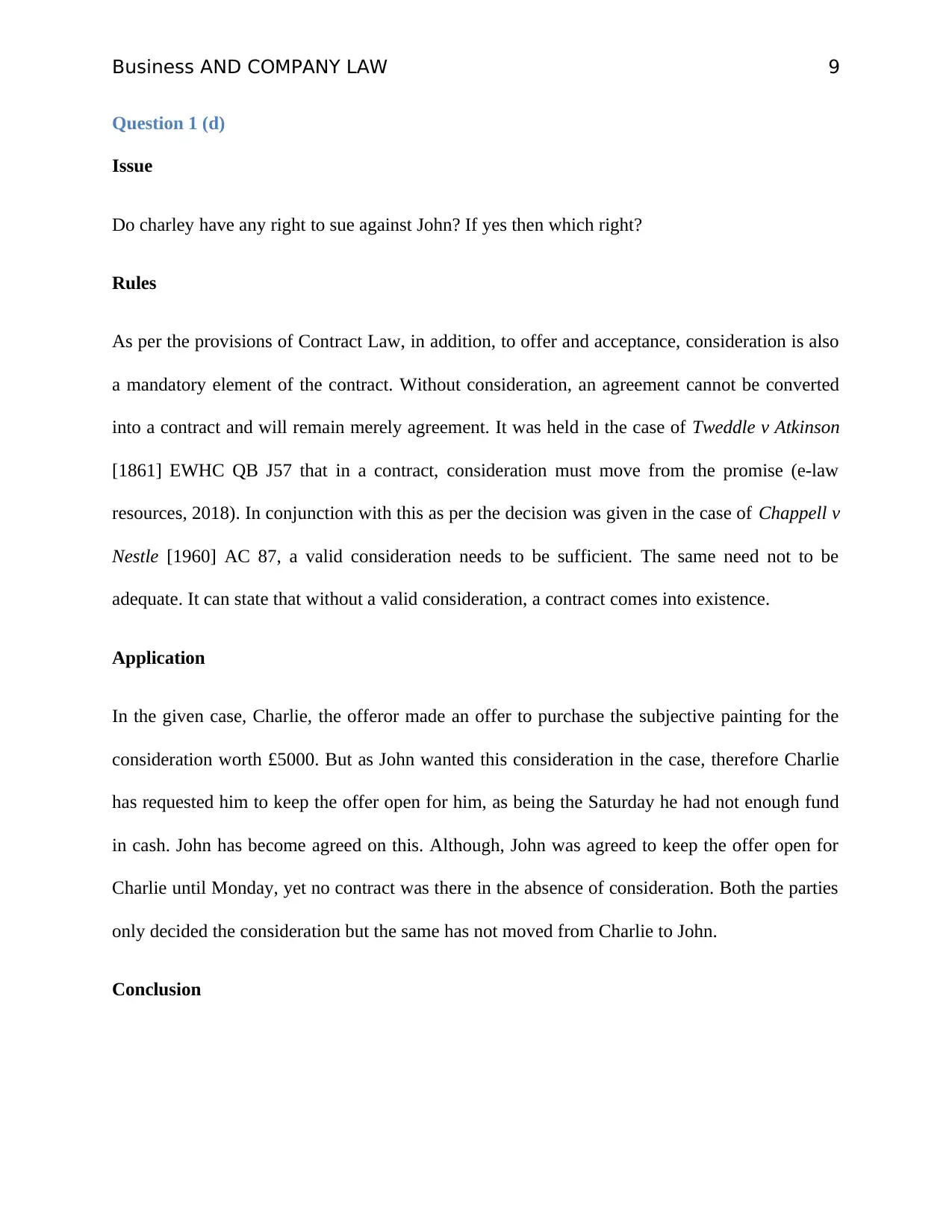
Business AND COMPANY LAW 9
Question 1 (d)
Issue
Do charley have any right to sue against John? If yes then which right?
Rules
As per the provisions of Contract Law, in addition, to offer and acceptance, consideration is also
a mandatory element of the contract. Without consideration, an agreement cannot be converted
into a contract and will remain merely agreement. It was held in the case of Tweddle v Atkinson
[1861] EWHC QB J57 that in a contract, consideration must move from the promise (e-law
resources, 2018). In conjunction with this as per the decision was given in the case of Chappell v
Nestle [1960] AC 87, a valid consideration needs to be sufficient. The same need not to be
adequate. It can state that without a valid consideration, a contract comes into existence.
Application
In the given case, Charlie, the offeror made an offer to purchase the subjective painting for the
consideration worth £5000. But as John wanted this consideration in the case, therefore Charlie
has requested him to keep the offer open for him, as being the Saturday he had not enough fund
in cash. John has become agreed on this. Although, John was agreed to keep the offer open for
Charlie until Monday, yet no contract was there in the absence of consideration. Both the parties
only decided the consideration but the same has not moved from Charlie to John.
Conclusion
Question 1 (d)
Issue
Do charley have any right to sue against John? If yes then which right?
Rules
As per the provisions of Contract Law, in addition, to offer and acceptance, consideration is also
a mandatory element of the contract. Without consideration, an agreement cannot be converted
into a contract and will remain merely agreement. It was held in the case of Tweddle v Atkinson
[1861] EWHC QB J57 that in a contract, consideration must move from the promise (e-law
resources, 2018). In conjunction with this as per the decision was given in the case of Chappell v
Nestle [1960] AC 87, a valid consideration needs to be sufficient. The same need not to be
adequate. It can state that without a valid consideration, a contract comes into existence.
Application
In the given case, Charlie, the offeror made an offer to purchase the subjective painting for the
consideration worth £5000. But as John wanted this consideration in the case, therefore Charlie
has requested him to keep the offer open for him, as being the Saturday he had not enough fund
in cash. John has become agreed on this. Although, John was agreed to keep the offer open for
Charlie until Monday, yet no contract was there in the absence of consideration. Both the parties
only decided the consideration but the same has not moved from Charlie to John.
Conclusion
Secure Best Marks with AI Grader
Need help grading? Try our AI Grader for instant feedback on your assignments.
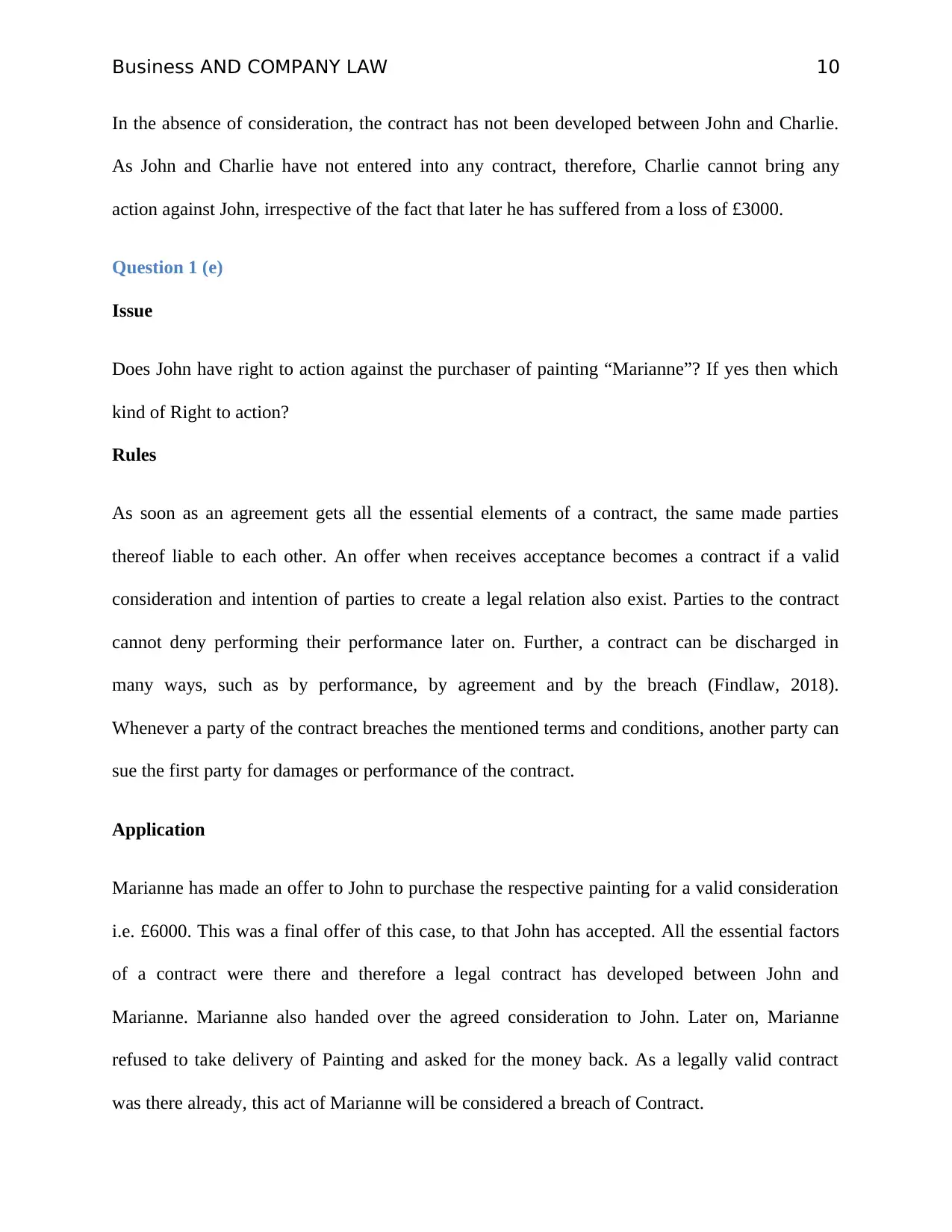
Business AND COMPANY LAW 10
In the absence of consideration, the contract has not been developed between John and Charlie.
As John and Charlie have not entered into any contract, therefore, Charlie cannot bring any
action against John, irrespective of the fact that later he has suffered from a loss of £3000.
Question 1 (e)
Issue
Does John have right to action against the purchaser of painting “Marianne”? If yes then which
kind of Right to action?
Rules
As soon as an agreement gets all the essential elements of a contract, the same made parties
thereof liable to each other. An offer when receives acceptance becomes a contract if a valid
consideration and intention of parties to create a legal relation also exist. Parties to the contract
cannot deny performing their performance later on. Further, a contract can be discharged in
many ways, such as by performance, by agreement and by the breach (Findlaw, 2018).
Whenever a party of the contract breaches the mentioned terms and conditions, another party can
sue the first party for damages or performance of the contract.
Application
Marianne has made an offer to John to purchase the respective painting for a valid consideration
i.e. £6000. This was a final offer of this case, to that John has accepted. All the essential factors
of a contract were there and therefore a legal contract has developed between John and
Marianne. Marianne also handed over the agreed consideration to John. Later on, Marianne
refused to take delivery of Painting and asked for the money back. As a legally valid contract
was there already, this act of Marianne will be considered a breach of Contract.
In the absence of consideration, the contract has not been developed between John and Charlie.
As John and Charlie have not entered into any contract, therefore, Charlie cannot bring any
action against John, irrespective of the fact that later he has suffered from a loss of £3000.
Question 1 (e)
Issue
Does John have right to action against the purchaser of painting “Marianne”? If yes then which
kind of Right to action?
Rules
As soon as an agreement gets all the essential elements of a contract, the same made parties
thereof liable to each other. An offer when receives acceptance becomes a contract if a valid
consideration and intention of parties to create a legal relation also exist. Parties to the contract
cannot deny performing their performance later on. Further, a contract can be discharged in
many ways, such as by performance, by agreement and by the breach (Findlaw, 2018).
Whenever a party of the contract breaches the mentioned terms and conditions, another party can
sue the first party for damages or performance of the contract.
Application
Marianne has made an offer to John to purchase the respective painting for a valid consideration
i.e. £6000. This was a final offer of this case, to that John has accepted. All the essential factors
of a contract were there and therefore a legal contract has developed between John and
Marianne. Marianne also handed over the agreed consideration to John. Later on, Marianne
refused to take delivery of Painting and asked for the money back. As a legally valid contract
was there already, this act of Marianne will be considered a breach of Contract.
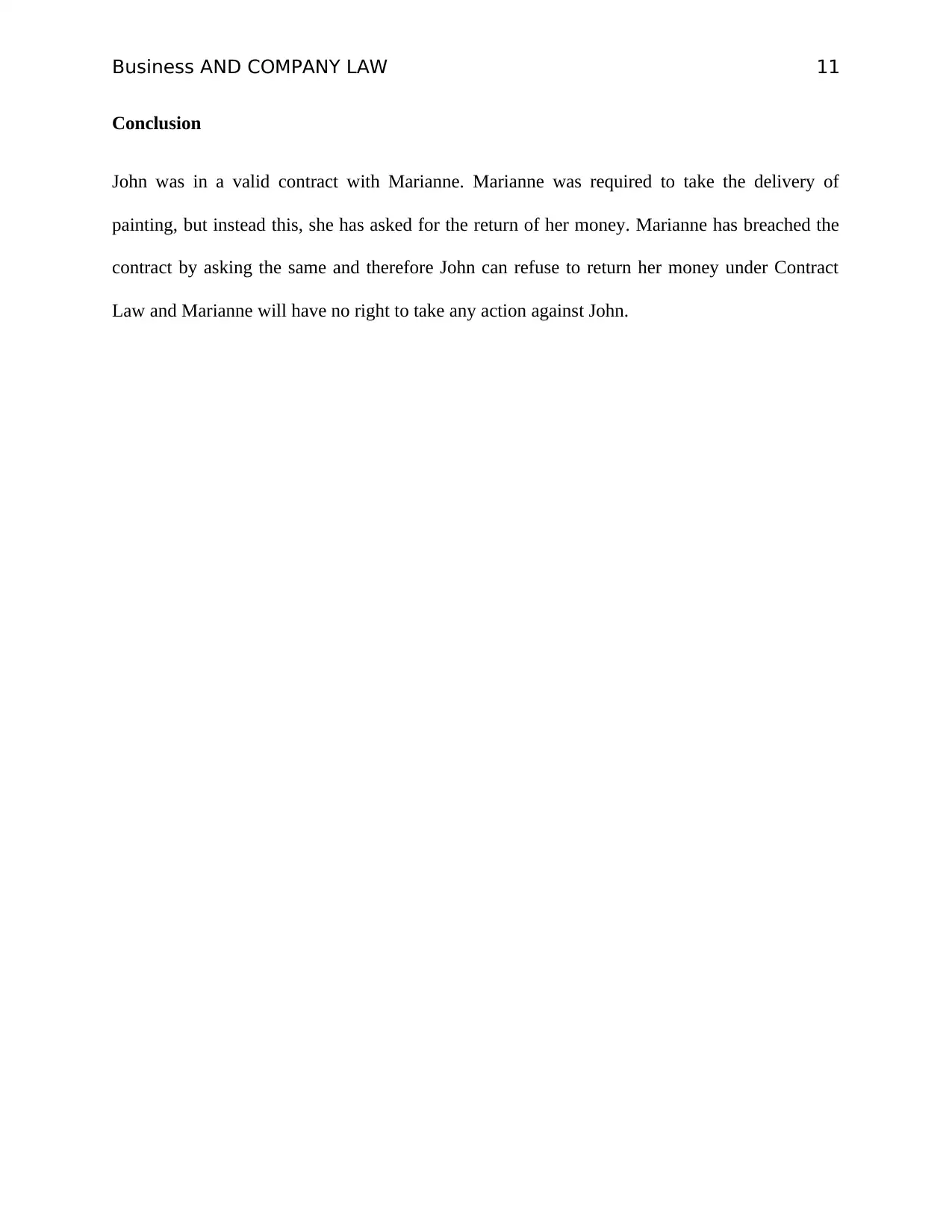
Business AND COMPANY LAW 11
Conclusion
John was in a valid contract with Marianne. Marianne was required to take the delivery of
painting, but instead this, she has asked for the return of her money. Marianne has breached the
contract by asking the same and therefore John can refuse to return her money under Contract
Law and Marianne will have no right to take any action against John.
Conclusion
John was in a valid contract with Marianne. Marianne was required to take the delivery of
painting, but instead this, she has asked for the return of her money. Marianne has breached the
contract by asking the same and therefore John can refuse to return her money under Contract
Law and Marianne will have no right to take any action against John.
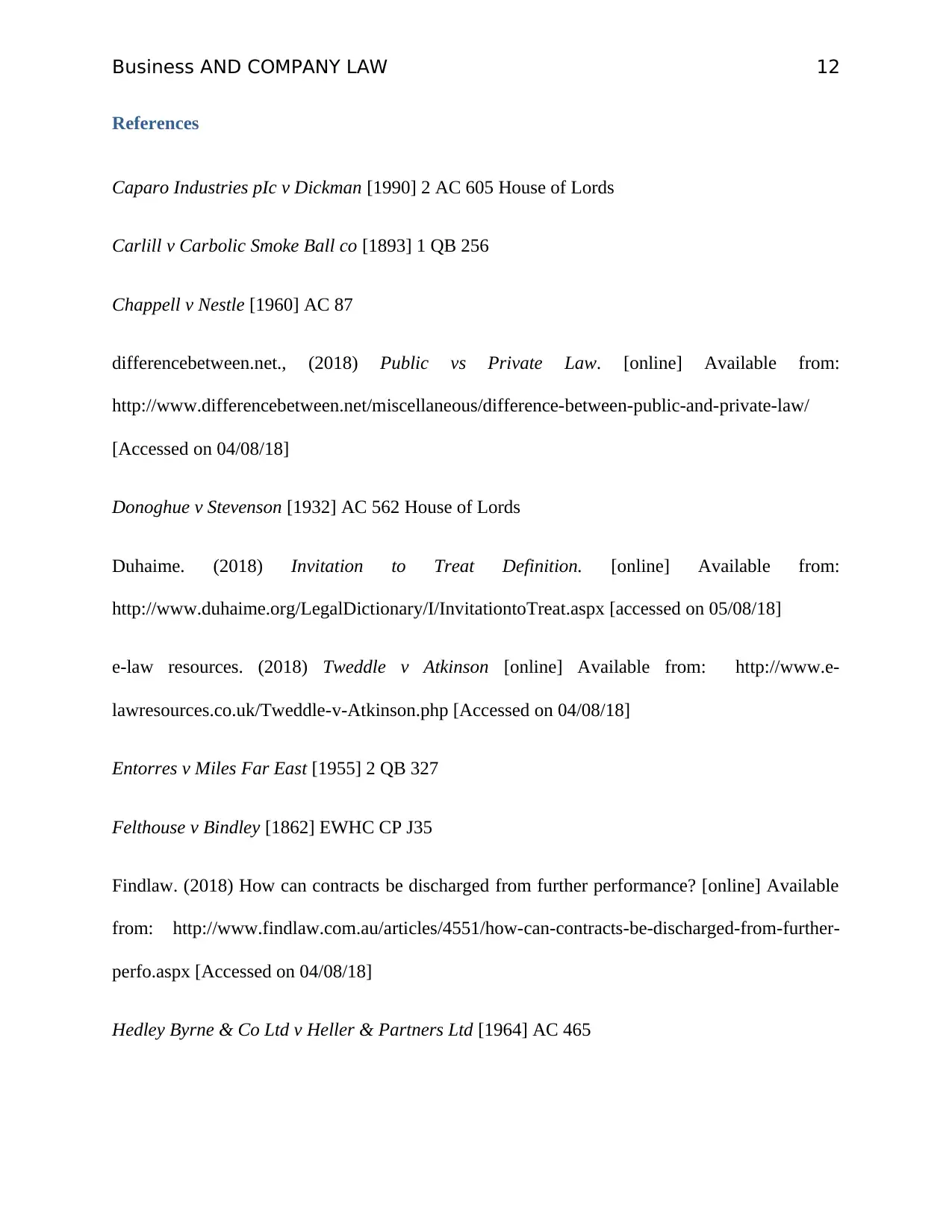
Business AND COMPANY LAW 12
References
Caparo Industries pIc v Dickman [1990] 2 AC 605 House of Lords
Carlill v Carbolic Smoke Ball co [1893] 1 QB 256
Chappell v Nestle [1960] AC 87
differencebetween.net., (2018) Public vs Private Law. [online] Available from:
http://www.differencebetween.net/miscellaneous/difference-between-public-and-private-law/
[Accessed on 04/08/18]
Donoghue v Stevenson [1932] AC 562 House of Lords
Duhaime. (2018) Invitation to Treat Definition. [online] Available from:
http://www.duhaime.org/LegalDictionary/I/InvitationtoTreat.aspx [accessed on 05/08/18]
e-law resources. (2018) Tweddle v Atkinson [online] Available from: http://www.e-
lawresources.co.uk/Tweddle-v-Atkinson.php [Accessed on 04/08/18]
Entorres v Miles Far East [1955] 2 QB 327
Felthouse v Bindley [1862] EWHC CP J35
Findlaw. (2018) How can contracts be discharged from further performance? [online] Available
from: http://www.findlaw.com.au/articles/4551/how-can-contracts-be-discharged-from-further-
perfo.aspx [Accessed on 04/08/18]
Hedley Byrne & Co Ltd v Heller & Partners Ltd [1964] AC 465
References
Caparo Industries pIc v Dickman [1990] 2 AC 605 House of Lords
Carlill v Carbolic Smoke Ball co [1893] 1 QB 256
Chappell v Nestle [1960] AC 87
differencebetween.net., (2018) Public vs Private Law. [online] Available from:
http://www.differencebetween.net/miscellaneous/difference-between-public-and-private-law/
[Accessed on 04/08/18]
Donoghue v Stevenson [1932] AC 562 House of Lords
Duhaime. (2018) Invitation to Treat Definition. [online] Available from:
http://www.duhaime.org/LegalDictionary/I/InvitationtoTreat.aspx [accessed on 05/08/18]
e-law resources. (2018) Tweddle v Atkinson [online] Available from: http://www.e-
lawresources.co.uk/Tweddle-v-Atkinson.php [Accessed on 04/08/18]
Entorres v Miles Far East [1955] 2 QB 327
Felthouse v Bindley [1862] EWHC CP J35
Findlaw. (2018) How can contracts be discharged from further performance? [online] Available
from: http://www.findlaw.com.au/articles/4551/how-can-contracts-be-discharged-from-further-
perfo.aspx [Accessed on 04/08/18]
Hedley Byrne & Co Ltd v Heller & Partners Ltd [1964] AC 465
Paraphrase This Document
Need a fresh take? Get an instant paraphrase of this document with our AI Paraphraser
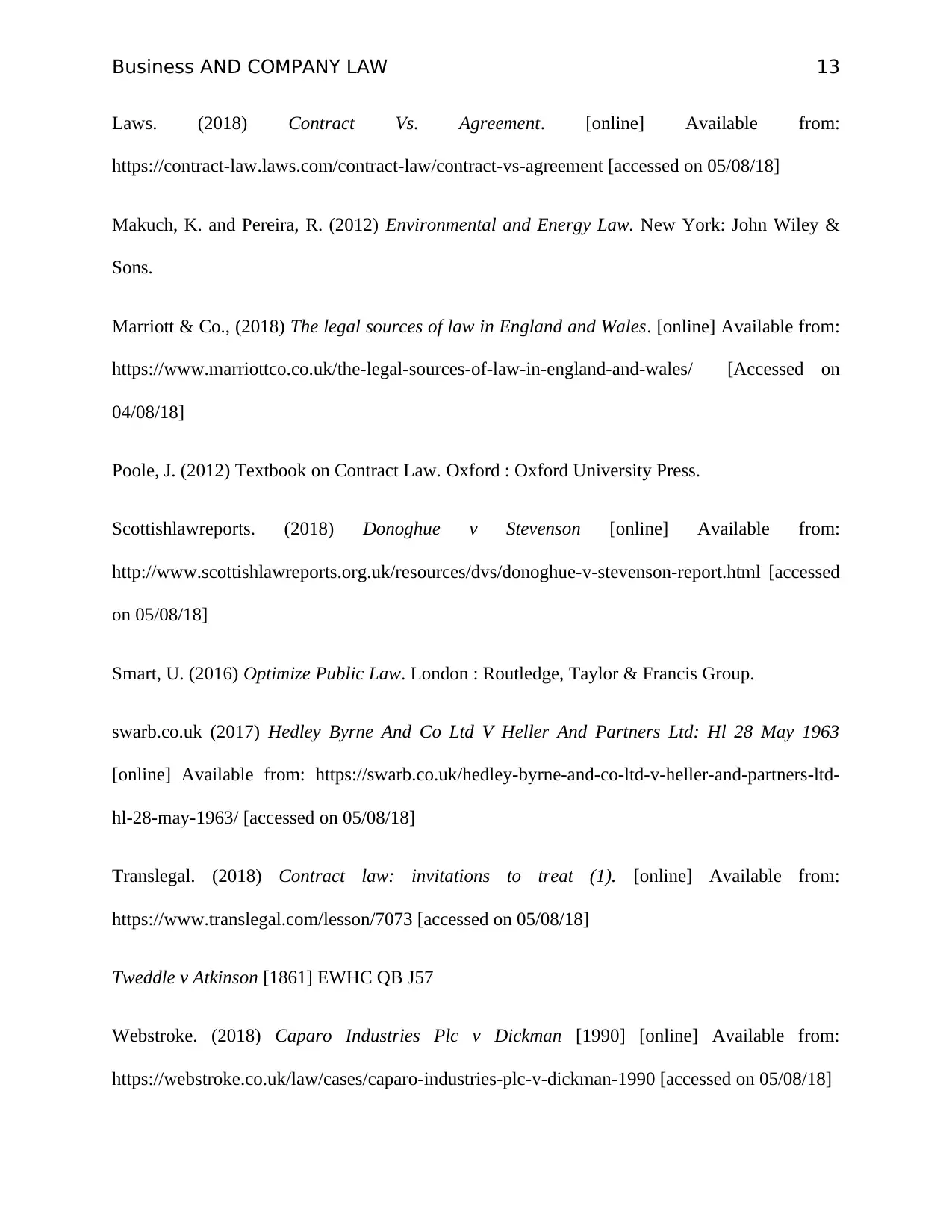
Business AND COMPANY LAW 13
Laws. (2018) Contract Vs. Agreement. [online] Available from:
https://contract-law.laws.com/contract-law/contract-vs-agreement [accessed on 05/08/18]
Makuch, K. and Pereira, R. (2012) Environmental and Energy Law. New York: John Wiley &
Sons.
Marriott & Co., (2018) The legal sources of law in England and Wales. [online] Available from:
https://www.marriottco.co.uk/the-legal-sources-of-law-in-england-and-wales/ [Accessed on
04/08/18]
Poole, J. (2012) Textbook on Contract Law. Oxford : Oxford University Press.
Scottishlawreports. (2018) Donoghue v Stevenson [online] Available from:
http://www.scottishlawreports.org.uk/resources/dvs/donoghue-v-stevenson-report.html [accessed
on 05/08/18]
Smart, U. (2016) Optimize Public Law. London : Routledge, Taylor & Francis Group.
swarb.co.uk (2017) Hedley Byrne And Co Ltd V Heller And Partners Ltd: Hl 28 May 1963
[online] Available from: https://swarb.co.uk/hedley-byrne-and-co-ltd-v-heller-and-partners-ltd-
hl-28-may-1963/ [accessed on 05/08/18]
Translegal. (2018) Contract law: invitations to treat (1). [online] Available from:
https://www.translegal.com/lesson/7073 [accessed on 05/08/18]
Tweddle v Atkinson [1861] EWHC QB J57
Webstroke. (2018) Caparo Industries Plc v Dickman [1990] [online] Available from:
https://webstroke.co.uk/law/cases/caparo-industries-plc-v-dickman-1990 [accessed on 05/08/18]
Laws. (2018) Contract Vs. Agreement. [online] Available from:
https://contract-law.laws.com/contract-law/contract-vs-agreement [accessed on 05/08/18]
Makuch, K. and Pereira, R. (2012) Environmental and Energy Law. New York: John Wiley &
Sons.
Marriott & Co., (2018) The legal sources of law in England and Wales. [online] Available from:
https://www.marriottco.co.uk/the-legal-sources-of-law-in-england-and-wales/ [Accessed on
04/08/18]
Poole, J. (2012) Textbook on Contract Law. Oxford : Oxford University Press.
Scottishlawreports. (2018) Donoghue v Stevenson [online] Available from:
http://www.scottishlawreports.org.uk/resources/dvs/donoghue-v-stevenson-report.html [accessed
on 05/08/18]
Smart, U. (2016) Optimize Public Law. London : Routledge, Taylor & Francis Group.
swarb.co.uk (2017) Hedley Byrne And Co Ltd V Heller And Partners Ltd: Hl 28 May 1963
[online] Available from: https://swarb.co.uk/hedley-byrne-and-co-ltd-v-heller-and-partners-ltd-
hl-28-may-1963/ [accessed on 05/08/18]
Translegal. (2018) Contract law: invitations to treat (1). [online] Available from:
https://www.translegal.com/lesson/7073 [accessed on 05/08/18]
Tweddle v Atkinson [1861] EWHC QB J57
Webstroke. (2018) Caparo Industries Plc v Dickman [1990] [online] Available from:
https://webstroke.co.uk/law/cases/caparo-industries-plc-v-dickman-1990 [accessed on 05/08/18]
1 out of 14
Related Documents
Your All-in-One AI-Powered Toolkit for Academic Success.
+13062052269
info@desklib.com
Available 24*7 on WhatsApp / Email
![[object Object]](/_next/static/media/star-bottom.7253800d.svg)
Unlock your academic potential
© 2024 | Zucol Services PVT LTD | All rights reserved.




